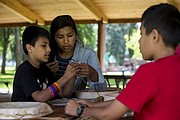Teaching tradition
COEUR d’ALENE — Drums made from deer hides created the beats for dancers to twirl and jump to while dressed in vibrant, traditional Native American garb. Men stood tall and proud, donning eagle feathers and colorful beading. Women moved gracefully on the balls of their feet and toes, their arms outstretched to showcase the flow of the fringe on their shawls.
Lessons about powwows and other American Indian traditions are the focus this week for Coeur d’Alene School District students attending Native American Cultural Enrichment Day Camp at the Human Rights Education Institute in Coeur d’Alene. The campers are enrolled tribal members who are there to help them better understand their heritage by engaging in activities led by tribal elders and community organizations.
Sarai Mays, the school district’s Indian Education coordinator, came up with the idea after noticing similar events took place in other school districts.
“Even though we have meetings three or four times a year, there are not a lot of people that come. This way, the kids can get to know each other and then maybe those relationships will continue... and the kids who don’t have close tribal ties will just learn more about part of their culture,” Mays said.
The day camp hosted transitioning fourth- through- eighth-graders from all schools in the district. Mays said there are more than 300 registered American Indian students in the district, so going to the schools and addressing them as a whole wouldn’t teach them about their heritage as thoroughly as a small-group environment would. Mays also said students in the district come from more than 62 different tribes.
Mark Stanger, also named Kekwa-Sile`, taught the boys to make hand drums from deer hides on Tuesday in Coeur d’Alene City Park. Stanger works for the Coeur d’Alene Tribe’s Fish and Wildlife department and often works with North Idaho College for outreach and education. He’s done events like this for more than 30 years and he’s traveled as a traditional dancer and singer for about 50.
“We can use drums for powwows or stick game; they’re very spiritual for us. We always say the drum is the heartbeat of our Native People,” Stanger said.
While the boys learned to make the drums, Melissa Melting-Tallow, a volunteer and American Indian tribal member, taught the girls to make “fancy shawls,” which are wraps with fringe used in “fancy dancing” to emphasize a woman’s grace as they step and hop to the drum’s beat on their toes. Stanger said songs are created when tribal members go into the mountains and listen to sounds of animals to inspire rhythm.
“Fancy dancing is what makes them all come together; it’s not just for one tribe,” Melting-Tallow said. “There’s this big drum and they’ll have a group of guys and women sit around it, and then they usually have a speaker or microphone in the middle and different drumming groups will play.”
After the boys finish their drums, Stanger will teach them beats on their hand drums and Melting-Tallow will teach the girls fancy dancing steps on Thursday.
The students also made fry bread, a traditional American Indian dish made from commodities given to the tribes by the U.S. government after it moved them to reservations. They learned about edible plants native to the area on Tubbs Hill.
Five volunteers helped to facilitate the activities. Some of them were doing it for volunteer hours and found this event to be more appealing than others. Jordan Ballenger, a volunteer for the day camp, needed hours for a class and found the day camp on a website that features volunteer opportunities in a given area.
“I thought it would be interesting... we played a stick game yesterday, which is a really cool Native American community game and we learned about some cultural stories about the coyote,” Ballenger said.
Mays said family is an important part of American Indian culture, and handing down the traditions is something they emphasize.
“It’s just a really different culture so we want to be able to hand these things down to our kids rather than always just being assimilated into the general culture,” Mays said.
Mays also hoped the public would learn something about their culture, too. She felt many people don’t realize American Indian nations are sovereign with their own governments. American Indian culture is often lost in an urban environment, so Mays wanted to make sure these students don’t forget where they came from.
“It’s just a totally different culture and we don’t have a lot of diversity here anyway... Here, I think they can feel like they belong to a bigger group and feel like they fit in better,” Mays said.



